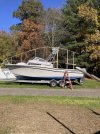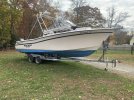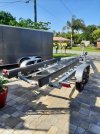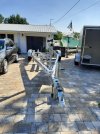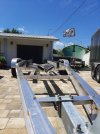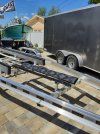Sorry about the confusion. Those 3 pictures at the start of this post are my boat. I couldn't figure out how to put a photo in a PM so I started a new thread.
My trailer is a Sea Lion S-28T-8200BB. Purchased December of 2013. Tires upgraded. I run LOADSTAR ST225/75R-15" RADIAL Tire, Load Range E at 80 psi.
From another post I wrote RE: Towing Grady with Jeep
I tow my 268 Islander from Cape May NJ to Islamorada and back every winter for the last 14 years. Same truck - 2007 Ford F150 with 9,000 lb towing capacity. Boat is 4,700 lbs, Yamaha F150's - 470 lbs each, trailer estimated 1,000 lbs, fuel usually light but lets say 75 gallons at 7 lbs = 525 lbs. Total 7,165 and with gear and household stuff it's close to 9,000 lbs. 24 hours seat time, 1,300 miles, 9 mpg around 60 mph +/- 5 MPH, locked out of overdrive. A little slow getting up to speed but easy drive. You can almost forget the boat is back there.
Trailer specs:
Dimensions
Overall Length 30'-8"
Length Boat: 26-28
Overall Width 101
Frame Type 5x3
Transom Height to Bow eye, Min: 21'-6" | Max: 26'-6"
Capacities
Cargo Capacity 8200 lbs
Wheels & Tires
Tires, Rear Specification Minimum: ST225/75D15D
Chassis
Axle Count Tandem Torsion


